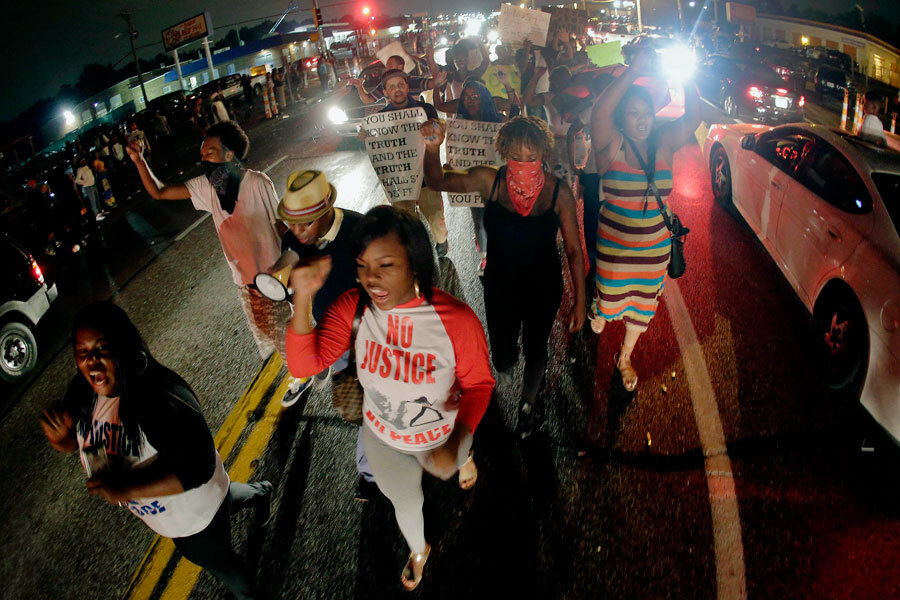As Mike Brown protests continue, how can Ferguson heal?
Loading...
| Ferguson, Mo.
On the streets of Ferguson, Mo., and perhaps in parts of the rest of America, it’s felt as a fundamental injustice, a palpable sense that no one with the power to do anything cares about the unarmed black teenager, dead on a Midwestern street, the victim of police gunshots.
During the past week, that sense of despair has built into a fierce energy that neither the armor clad officers of the Ferguson Police Department nor the softer touch of Highway Patrol Capt. Ron Johnson, the current commander of the crowd control effort, could manage. The anger that began building after officer Darren Wilson shot and killed Mike Brown last Saturday has resolutely failed to abate and has morphed into scenes more reminiscent of Gaza than the Great Plains.
On Saturday night, 150 protesters rebuffed a curfew and were scattered with smoke bombs and tear gas, marking the eighth night of conflict. Seven were arrested and one hurt by a gunshot that did not come from police.
It is a situation that has only one resolution, say many of the protesters – the arrest of Mr. Wilson – and every day of social unrest raises the stakes further. But it's far from certain where the facts will lead, or whether protesters' demands will ever be met.
Where does Ferguson go from here?
Wherever Ferguson goes, it seems, it must do so carefully. The city has always felt like a racially harmonious town, residents say. But the shooting has tapped into something deeply rooted, which is only now coming to the surface.
It has its origin in the white flight that has left largely black towns ruled by nearly all-white power structures here in greater St. Louis, say civil rights activists. This dynamic has undermined the trust necessary for police now to persuade protesters to remain peaceful and obey curfew. Only 12 percent of Ferguson residents vote, on average, suggesting either a highly mobile population or a demoralized one rife with a sense of disenfranchisement.
The strife also has its origin in a generational divide, say black leaders. While they attempt to keep protests peaceful, younger generations chafe at their message, not having seen the transformative impact of the civil rights movement in the 1960s. Protesting youth exclaimed Saturday night that “Mike Brown is our leader.”
And it has its origin in data that paint a portrait of a nation at war with its black youth. Of the roughly 400 reported police shootings a year, 18 percent are black teens and 9 percent are white teens, according to a recent USA Today analysis. Blacks make up 12 percent of the population, and a fraction of US police departments actually self-report such statistics.
Addressing such inequities and attitudes is “a conversation we need to have, and it’s going to be going on for a long time,” says Steve Smith, a St. Louis community activist.
The resolution the protesters are demanding, after all, is by no means assured. For much of the past week, the Ferguson Police Department has done little to counter the prevailing narrative, put forward by eyewitnesses, that Wilson killed Mr. Brown when Brown had raised his hands and was pleading with the officer not to shoot because he was unarmed.
“Hands up, don’t shoot!” has been a protest refrain, even taunt.
On Friday, however, Ferguson police released a video that purportedly shows Brown strong-arming a liquor store clerk after shoplifting cigars minutes before he was shot.
No one has suggested that the alleged theft precipitated the encounter between Wilson and Brown. All parties appear to agree that Wilson stopped Brown and a friend for jaywalking before the situation escalated. For that reason, Missouri Gov. Jay Nixon told CBS News that the video release seemed intended to “besmirch” Brown to build support for the officer. Police Chief Thomas Jackson said Friday that Wilson “is and has been an excellent police officer.”
Whatever the motive, the video did suggest that the story of that night could yet take further unexpected turns. Police say there was a struggle between the two men where the officer was hurt before Brown was killed.
“This is very delicate,” says Lance LoRusso, a former Cobb County, Ga., police officer and author of “When Cops Kill.” “People are saying Brown did not get the due process of the law, but in the same breath [protesters] want to deprive the accused, Officer Wilson, of his due process. I can’t imagine a more egregious injustice than bringing charges before the investigation is complete, irrespective of who is on the other side.”
The investigation is complicated. St. Louis County is carrying out a criminal investigation while the Justice Department is trying to determine whether Wilson violated Brown’s federal civil rights. On Sunday, the FBI ordered a second autopsy on Brown’s body, even though the local examiner had already written a report. While police now know the number of shots and where they came from, they are not releasing the autopsy until the conclusion of toxicology tests, which could take weeks.
Governor Nixon said Sunday that St. Louis County prosecutor Bob McCulloch has an “opportunity to step up” as he investigates whether Wilson’s decision to kill Brown was justifiable or murder.
The next few days are likely to produce more "angst and pressure" in Ferguson, Nixon said, as more details emerge about Brown’s death and protests likely continue. "There's a lot of steps between now and when justice is served – I think there are going to be some bumps along the road to justice."








